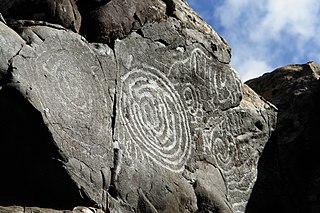
The Guanche were the indigenous inhabitants of the Spanish Canary Islands, located in the Atlantic Ocean some 100 kilometres (60 mi) to the west of modern Morocco and the North African coast. The islanders spoke the Guanche language, which is believed to have been related to the Berber languages of mainland North Africa; the language became extinct in the 17th century, soon after the islands were colonized.

The First Battle of Acentejo took place on the island of Tenerife between the Guanches and an alliance of Spaniards, other Europeans, and associated natives, on 31 May 1494, during the Spanish conquest of this island. It resulted in a victory for the Guanches of Tenerife.

Tinguaro was a Guanche sigoñe (transl. warrior) of Tenerife, also known as Chimechia and Achimenchia Tinguaro.
The Second Battle of Acentejo took place on 25 December 1494 between the invading Spanish forces and the natives of the island of Tenerife, known as Guanches. The battle had been preceded by the Battle of Aguere, fought on 14-15 November that year, which had been a Castilian victory.

Bencomo was the penultimate mencey or king of Taoro, a Guanche menceyato on the island of Tenerife. He fought in the First Battle of Acentejo, a victory for the Guanches against the invading Castilians, after having refused the terms of Alonso Fernández de Lugo. He may have perished on the heights of San Roque during the Battle of Aguere alongside his brother Tinguaro.

The Canary Islands have been known since antiquity. Until the Spanish colonization between 1402 and 1496, the Canaries were populated by an indigenous population, whose origin was Amazigh from North Africa.
The Battle of Aguere, or Battle of San Cristóbal de La Laguna, was fought between forces of the Crown of Castile, led by the Adelantado Alonso Fernández de Lugo, and the natives of Tenerife, called Guanches. The battle took place on 14-15 November 1494.

The Kingdom of the Canary Islands was a vassal state of the Crown of Castile located in North Africa, lasting from 1404 to 1448.

Acaimo or Acaymo was a Guanche mencey of Tacoronte, on the island of Tenerife at the time of the Spanish conquest in the 15th century. He formed an alliance against the Spaniards with the mencey Beneharo and the mencey Bencomo.

The conquest of the Canary Islands by the Crown of Castile took place between 1402 and 1496 and described as the first instance of European settler colonialism in Africa. It can be divided into two periods: the Conquista señorial, carried out by Castilian nobility in exchange for a covenant of allegiance to the crown, and the Conquista realenga, carried out by the Spanish crown itself, during the reign of the Catholic Monarchs.

Güímar was one of nine menceyatos guanches that was divided island of Tenerife at the time of the arrival of the Castilian conquerors. Occupied an area significantly greater than the actual municipality of Güímar, including part of Santa Cruz de Tenerife and San Cristóbal de La Laguna, El Rosario, Candelaria, Arafo and Fasnia, himself and perhaps a small part of the town of Arico.

Tinerfe "the Great", legendary hero who was a guanche mencey of the island of Tenerife. It is estimated that he lived at the end of the 14th century.

Princess Dácil was a Guanche princess of the kingdom of Taoro on the island of Tenerife, best known for her marriage to a conqueror of the island.

The Plaza de la Patrona de Canarias is a large square in Candelaria, Tenerife. It is next to the Basilica of Candelaria, a meeting place of pilgrims and festivities celebrating the most important of the municipality. In this square there are also various bars and cafes.

Adjona, also written Adxoña or Atxoña was the Guanche mencey (king) of the Menceyato de Abona at the time of the conquest of Tenerife in the fifteenth century.

Pelinor was a Guanche mencey king of Menceyato de Adeje at the time of the conquest of Tenerife in the 15th century.

Romen was a Guanche mencey king of Menceyato de Daute in times of the conquest of Tenerife in the fifteenth century.

Tegueste or Tegueste II was a Guanche King (mencey) of Menceyato de Tegueste, reigning during the conquest of Tenerife in the fifteenth century.

Bentor, sometimes also called Ventor, Bentore, Benytomo, or Bentorey, was the last mencey or king of Taoro from November 1494 until his suicide in February 1495. A native Guanche prince in the Canary Islands during the second half of the 15th century, Bentor was the eldest grandson of Bencomo, the penultimate mencey of Taoro. Taoro was one of nine menceyatos, or kingdoms, on the island of Tenerife in the Canary Islands before the Spanish conquest of the islands. Bentor's mother was probably named Hañagua, although this is unclear. He succeeded his grandfather as mencey upon his father's death in November 1494, and led the kingdom until his own death by suicide four months later, in February 1495. Bentor had five siblings: one sister (Dácil) and four brothers.
Guañameñe or Guadameñe was the name of a Guanche fortune-teller who had prophesied the arrival of the Castilian conquerors to the island of Tenerife at the end of the fifteenth century. Subsequently, the word Guañameñe was extended to denominate the highest priestly rank of the Guanche society.















